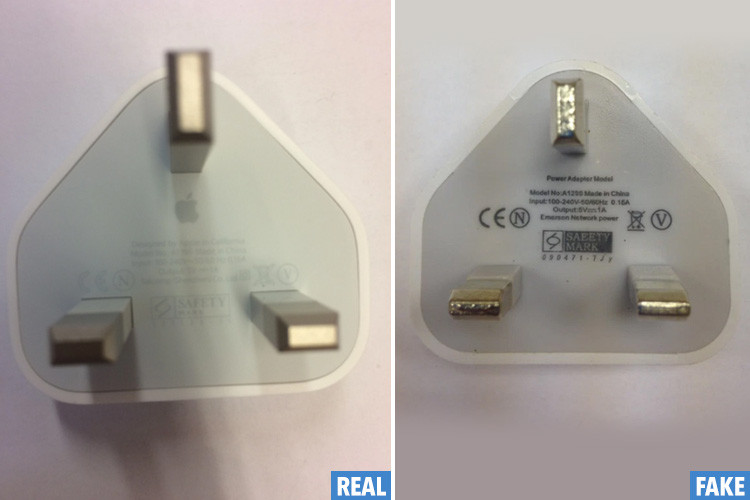

We’ve seen an increase in the number of incidents being reported about fake, cheap and unbranded chargers – many of which fail to meet UK safety regulations and can lead to electric shock, injury and cause fires.
With that in mind, it’s important to be aware of the risks when buying a phone charger.

You don’t need to be an expert to spot the difference between a genuine and fake Apple charger – our handy guide will tell you everything you need to know.
Look for missing markings (like the CE mark) or spelling errors. These are the easiest way to spot a counterfeit – but beware, as fake products are becoming more sophisticated.
This can be another fairly obvious indicator of a fake. The finish on a genuine charger is high quality, matte and uniform. On counterfeit chargers the finish is usually glossy or shiny with imperfections.
The USB port on a counterfeit charger might be upside down, or in a different place. A genuine charger will also have a serial number at the back of the USB port.
Our testing has shown that the pins on counterfeit plugs are much weaker than required by the standard. This is typically because they are metal-coated hollow plastic, rather than the solid metal used in genuine products. An easy check for this is to simply flick the largest pin and listen to the noise it makes. A genuine plug will sound and feel solid, while counterfeit products will make a ‘plastic’ noise and feel hollow.
As counterfeit chargers contain few, if any, of the higher quality components required for safety, they are usually significantly lighter than genuine chargers. The charger should weigh at least 40g.
The plug pins on a fake Apple charger may be larger or smaller than a genuine one, and may be positioned in a different place. The easiest way to check is by using the Electrical Safety First plug checker tool.
Plug pins
Markings
Warnings and Instructions
Statistics and facts
Many imported chargers do not satisfy UK safety regulations and can cause serious electric shock, injury or fire.
Suppliers and retailers have a legal duty to ensure that all electrical equipment they sell is safe.
We have just completed the installation of this contemporary external garage lighting. The three LED downlights are operated by a timer and flood the garage doors with light. The light splashes onto the surrounding driveway…
Customer: Can you change two light bulbs please? Prolectrical: Yes of course. What type of fittings are they for? Customer: Lamp posts… about 4 meters high! Prolectrical: No problem! [caption id="attachment_649" align="alignnone" width="450"] How may…
Electrical installations come in all sorts of shapes and sizes and this particular installation is one of the largest single domestic installations Prolectrical Limited have carried out since lead electrician Jon Adkins started out in…
Take a look at your own fuse board today! Take a look at your fuse board now. If you have one that looks like any of the boards pictured here, then it is time to…
How do you know if your home is electrically safe? Here are some simple electrical safety checks you can undertake in your home to check your electrical installation is in good working order! 1. Check…
It's a terrifying statistic but it is confirmed that 25% of house fires are caused by electrical failure! Prolectrical, who are by no means unfamiliar with dealing with dangerous electrical faults, learned recently at ECA…
Counterfeit phone chargers can be deadly. We’ve seen an increase in the number of incidents being reported about fake, cheap and unbranded chargers - many of which fail to meet UK safety regulations and can…
People over 65 at greater risk of being involved in a fire. The UK’s leading registration body for electricians is urging people to think electrics when they carry out their checks on the elderly this…






